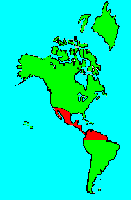SPECIES INFO
Red crowned woodpecker (Melanerpes rubricapillus) is found from south western Costa Rica south to Colombia and east to Tobago and the Guyanas. This is also found on various islands in the vicinity. This 7 inch woodpecker has a white face, white throat, and white breast. The lower breast is faintly marked with some stripes. The cape is red. The upper back is black and white striped with narrow stripes. The female has a white head, and shows only a small red patch on the back of her neck.
There are four subspecies. The nominate subspecies, Melanerpes rubricapillus rubricapillus, is found from Costa Rica to the Guyanas. The subspecies subfusculus is found on Coiba Island near Panama. The subspecies sedutus is found on San Miguel Island near Panama. The subspecies paraguanae is found on Paraguana Peninsula in northern Venezuela.The woodpecker genus Melanerpes is found from Canada south through the USA to and through Central America into much of mainland South America. There are about 32 species in the genus.
In 2003 Wilson-Reeder counted 22 species. In 2014 Gorman counted 24 species. Gorman has promoted two subspecies to full species status. (We suspect several members of this genus have been transferred to at least one other genus.)
Most species have lengths less than 12 inches. The color combinations of several of the species in this genus are very spectacular.
With about 216 species of woodpeckers known, we have arbitrarily divided this family into five geographic sections to help facilitate study of this group.
Woodpeckers (Family Picidae) are a family of over 200 species including the familiar woodpecker and some other primitive birds. Most of the species in this family are adapted to searching for food in the wood of trees.
Monroe and Sibley have increased the count to 216 species as of 1993. Howard and Moore in 2003 counted 210 species. Gorman in 2014 counted 239 species.
Several species are quite large and several are almost tiny. The great slaty woodpecker of the Indo-Australian region can reach over 20 inches in length. The extinct ivory billed woodpecker of North America was also about 20 inches in length. The white browed piculet of the China- SE Asian region is less than 4 inches in length.
We have divided the Picidae into 5 major groups. We provided one for each of the five major geographical regions. However, we created an additional 4 special groups following four of the major groups, as we felt the Wrynecks and Piculet groups should be separated out.
Woodpeckers and Toucans (Order Piciformes) are separated from most other birds by an unusual tendon and foot arrangement that includes two forward and two rear pointing toes. There are six families in this order. Most species in this order have unusual bills adapted for their unique way of obtaining food.
Some taxonomists place the puffbirds and jacamars in various places in the taxonomy tree. We have included the puffbirds (Bucconidae) and jacamars (Galbulidae) herein.
Aves contains about 8,650 different species of living birds known to science. Each year about one new species is discovered in some remote rain forest or remote island. In addition, scientists have been raising many subspecies to full species status which may raise the species count to 10,000. Birdlife recognizes 10,027 species as of 2011.
However, each year about one species goes extinct. The rate of extinction is increasing, and the rate of new discovery is decreasing, so that the number of bird species will soon begin to decline rapidly. Although different taxonomists would organize the birds differently, there are approximately twenty-seven orders of birds. These orders are broken down into about one hundred and fifty-five different families.
Recent research of the genetic structure of some of the shore birds and owls would indicate that the present organization of orders and families should have some modification.
The birds are a worldwide group of animals that are characterized by having the front limbs modified into wings that are used for flying. Perhaps the most unique feature of the birds is the feathers. These feathers are made up of a central support called a quill and a series of small filaments that are hooked together as barbs.
For many years it was believed that Archaeopteryx discovered in Bavaria was the oldest bird from about 150 million years ago. However, in l986, Sankar Chattterjee, a Texas paleontologist, reportedly discovered a bird in the genus Protoavis that lived about 225 million years ago.
When this project was begun in 1978, we used Austin & Singer for bird taxonomy. Since then, we have adopted many changes, but have kept some older concepts that are still found widely in the literature. Recently, we have used Clements and Howard & Moore. Very recently, we have used Monroe and Sibley for the higher taxonomy of the perching birds.
Backboned Animals (Phylum Chordata) are the most advanced group of animals on earth. These animals are characterized by having a spinal cord or backbone. Most members have a clearly defined brain that controls the organism through a spinal cord. Fish, amphibians, reptiles, birds, and mammals are in this phylum.
Currently, some taxonomists believe that the fish should be divided into two groups (sharks and regular fishes) and that there are some other primitive groups in the phylum such as hagfish or lampreys.
Animal Kingdom contains numerous organisms that feed on other animals or plants. Included in the animal kingdom are the lower marine invertebrates such as sponges and corals, the jointed legged animals such as insects and spiders, and the backboned animals such as fish, amphibians, reptiles, birds, and mammals.

